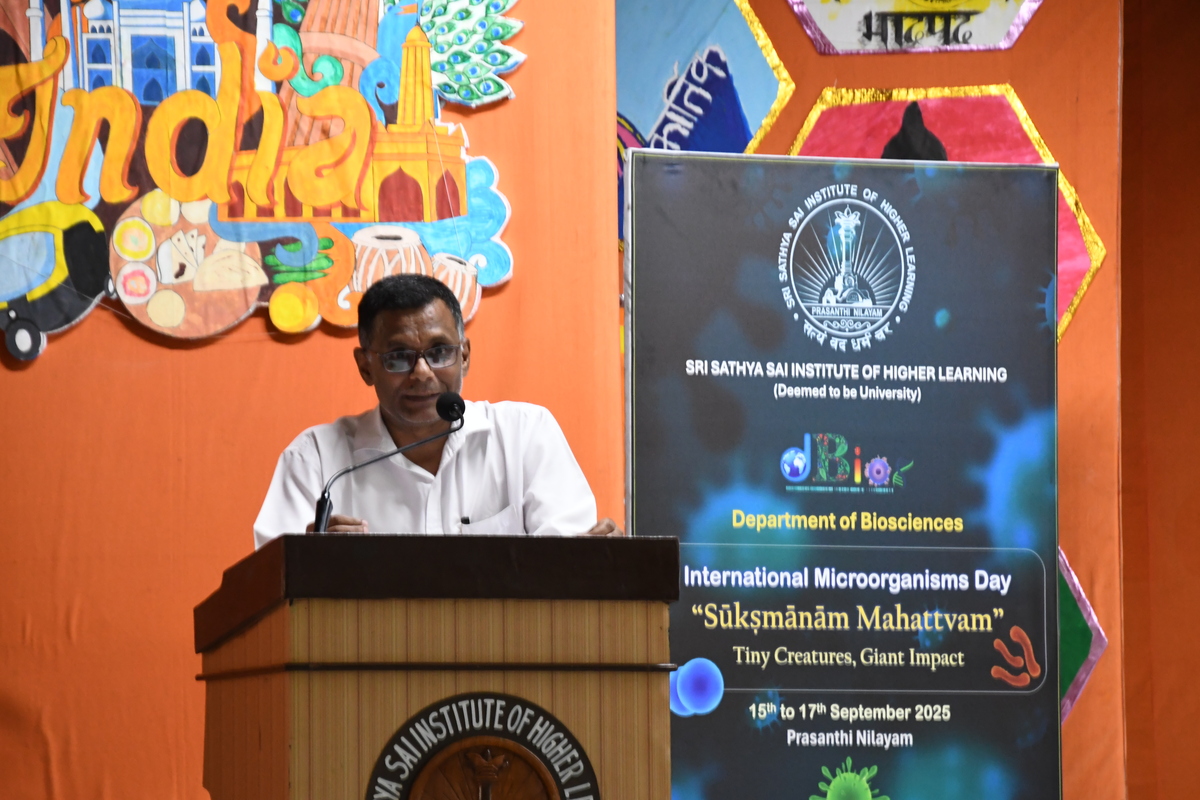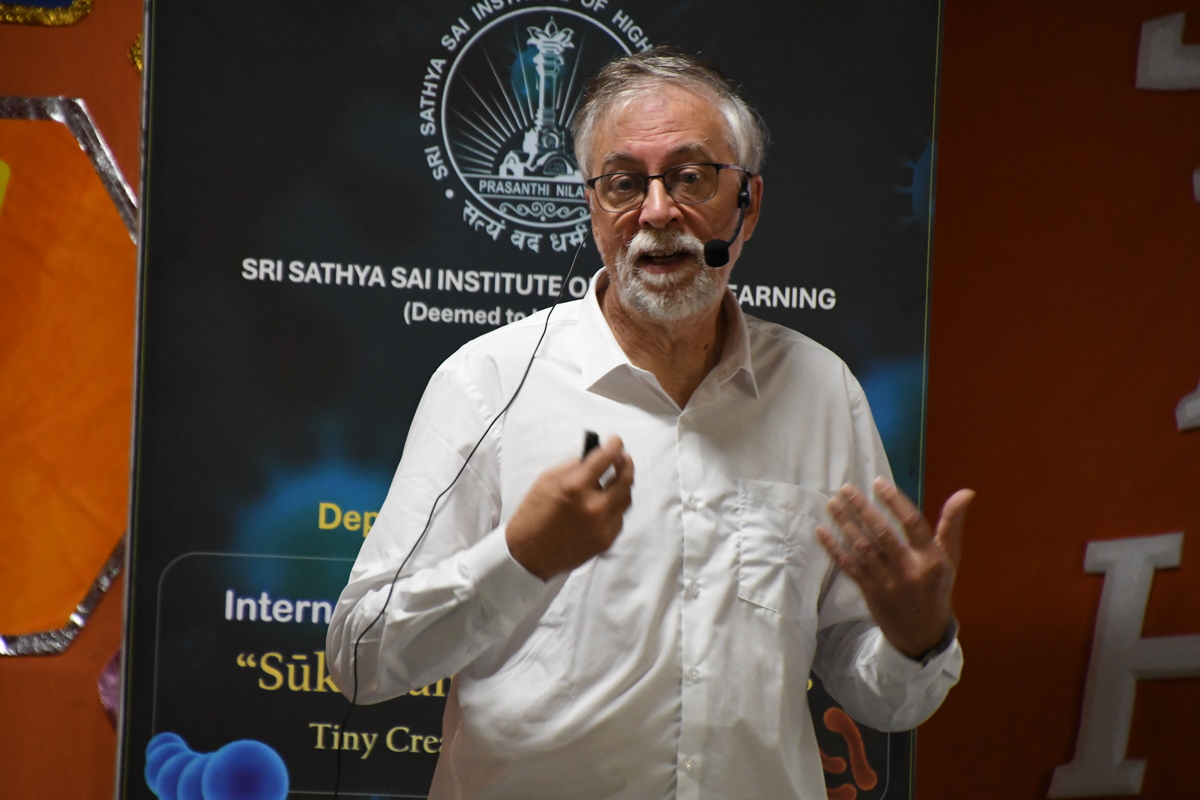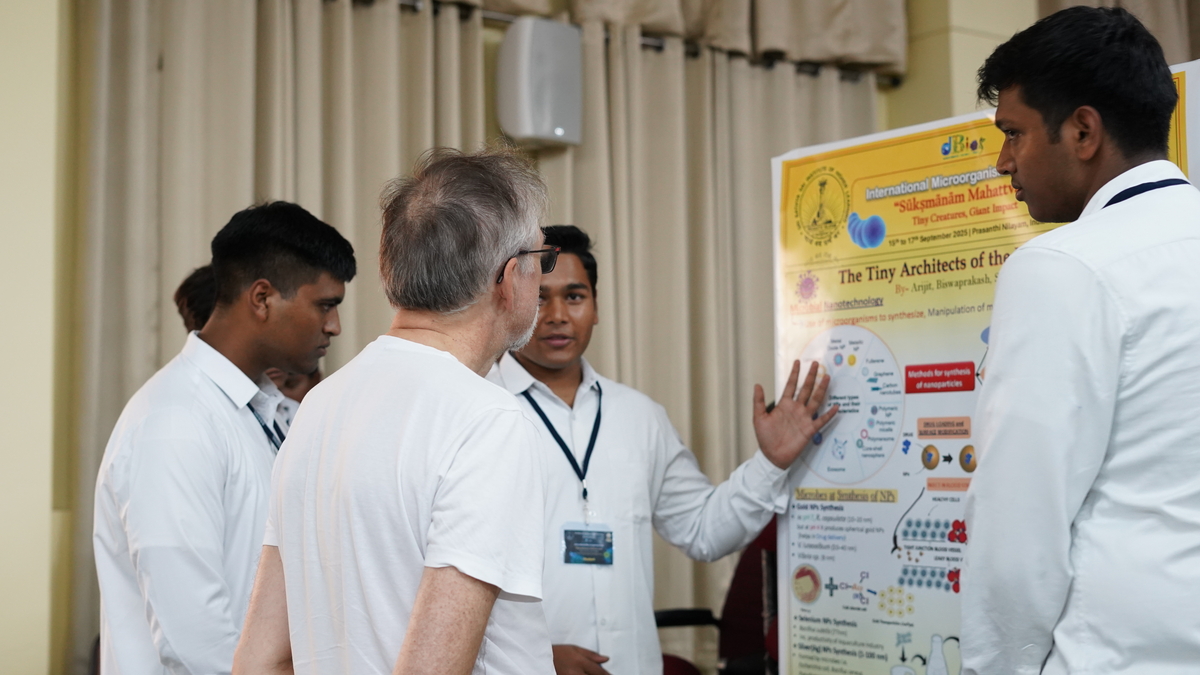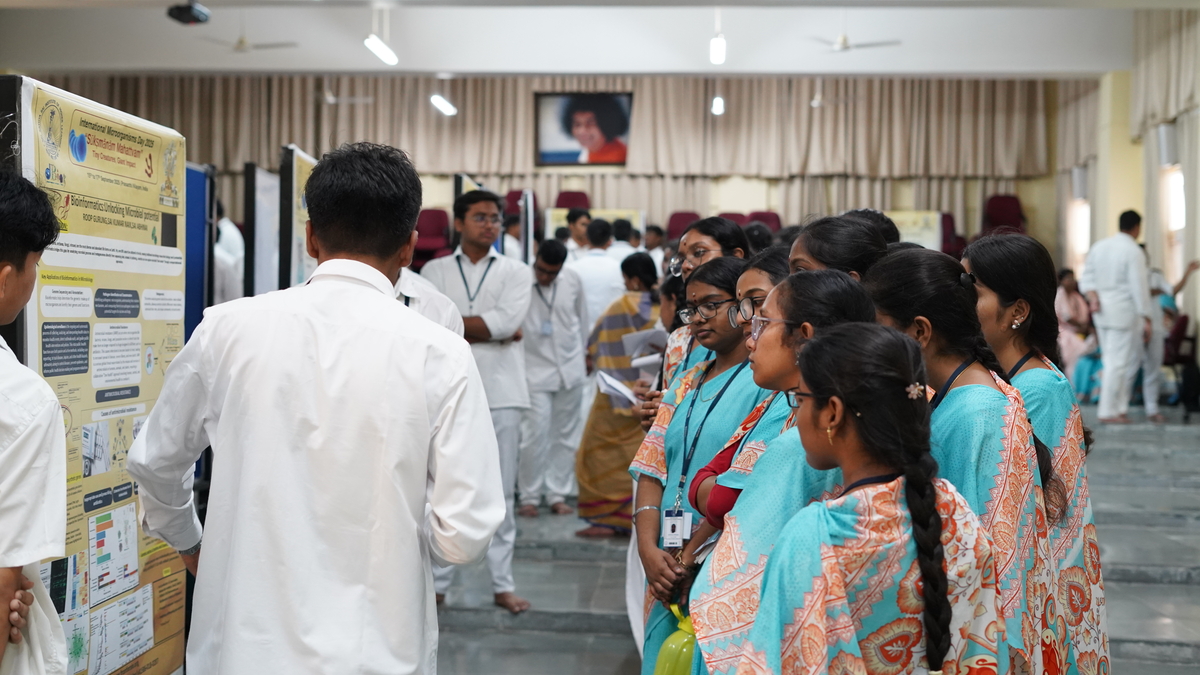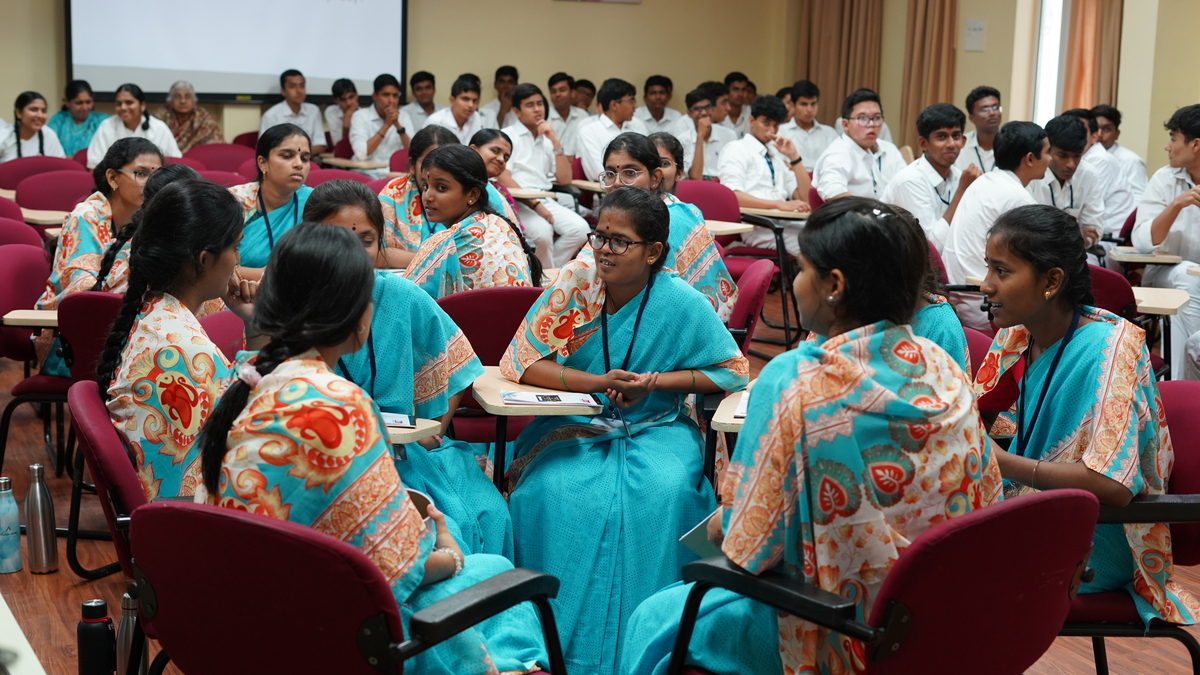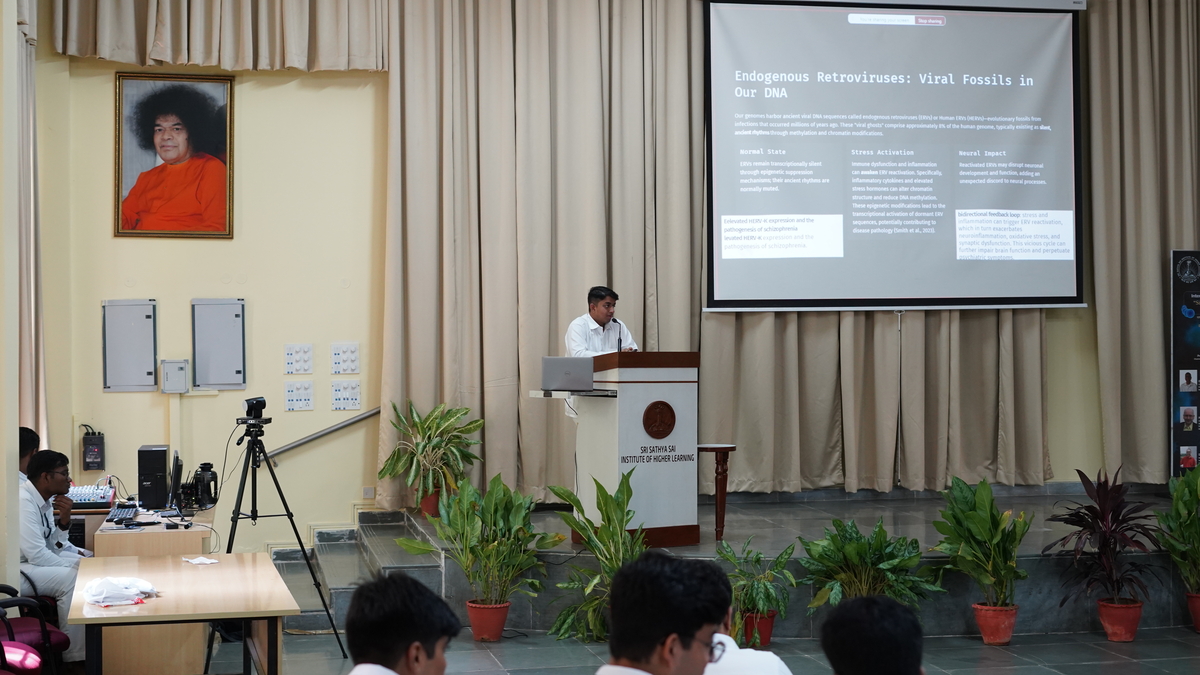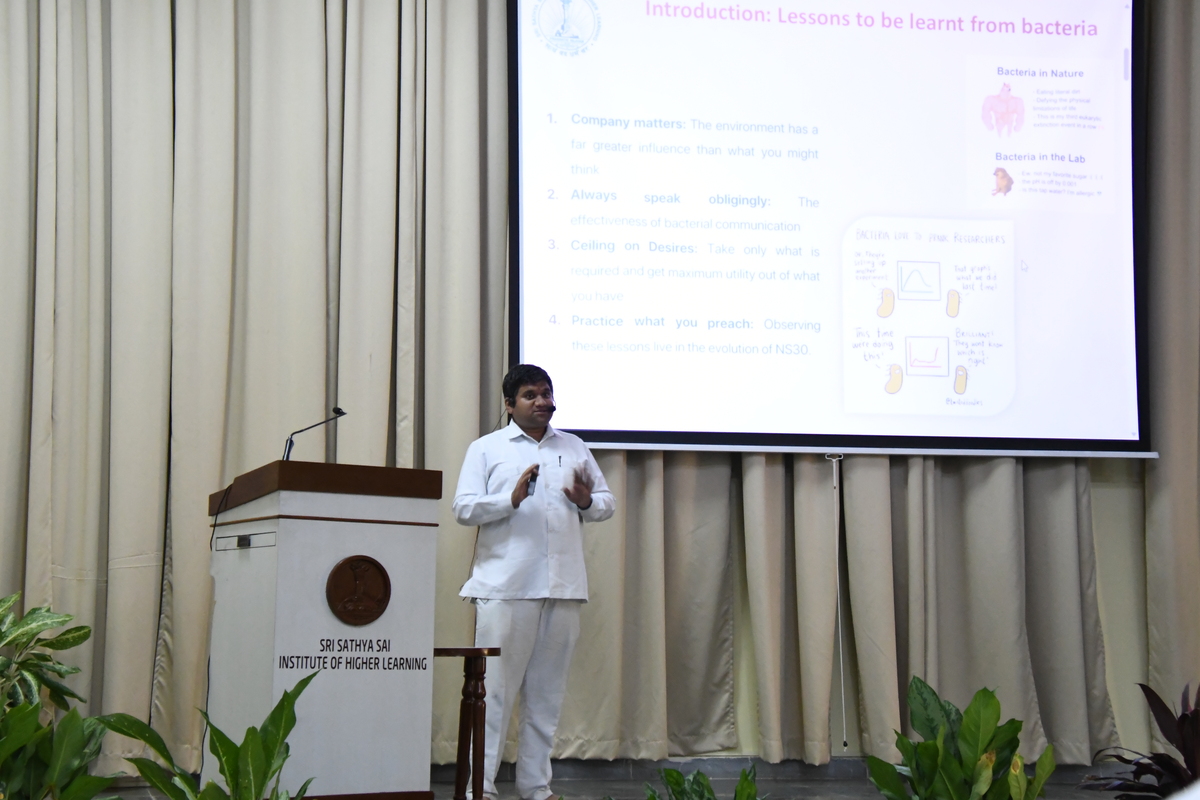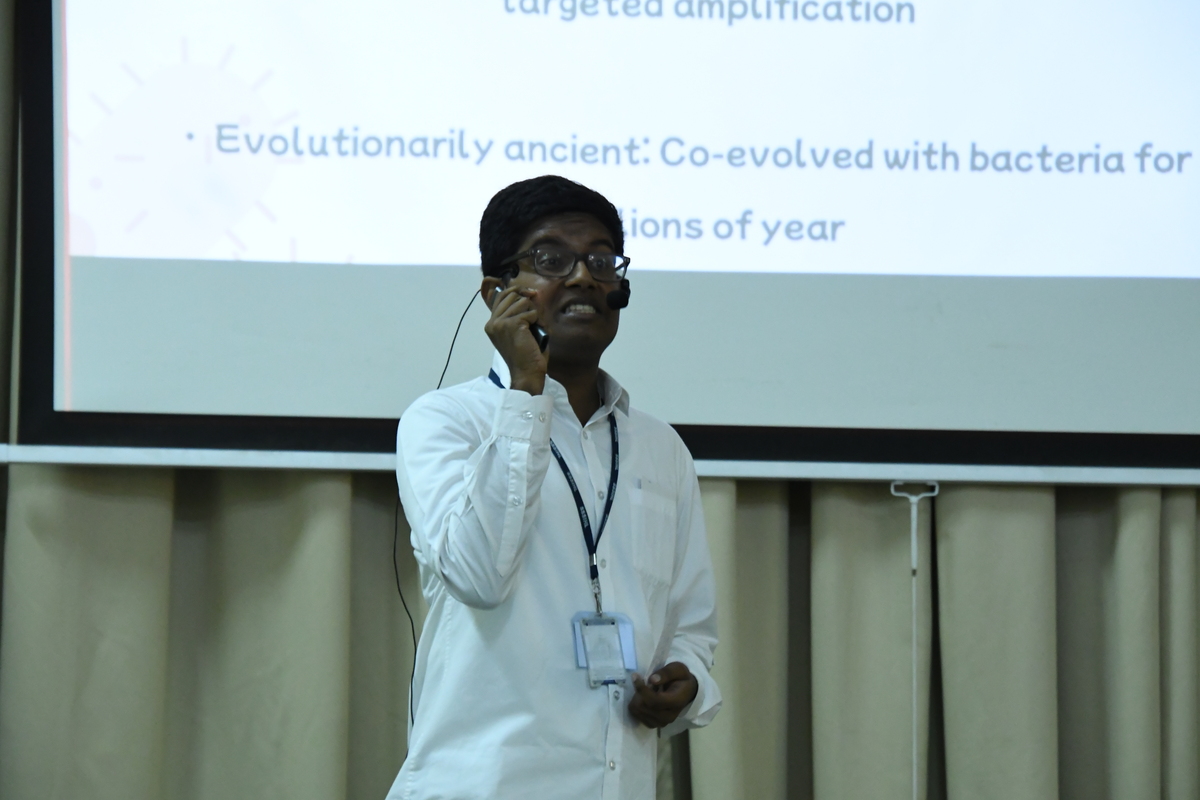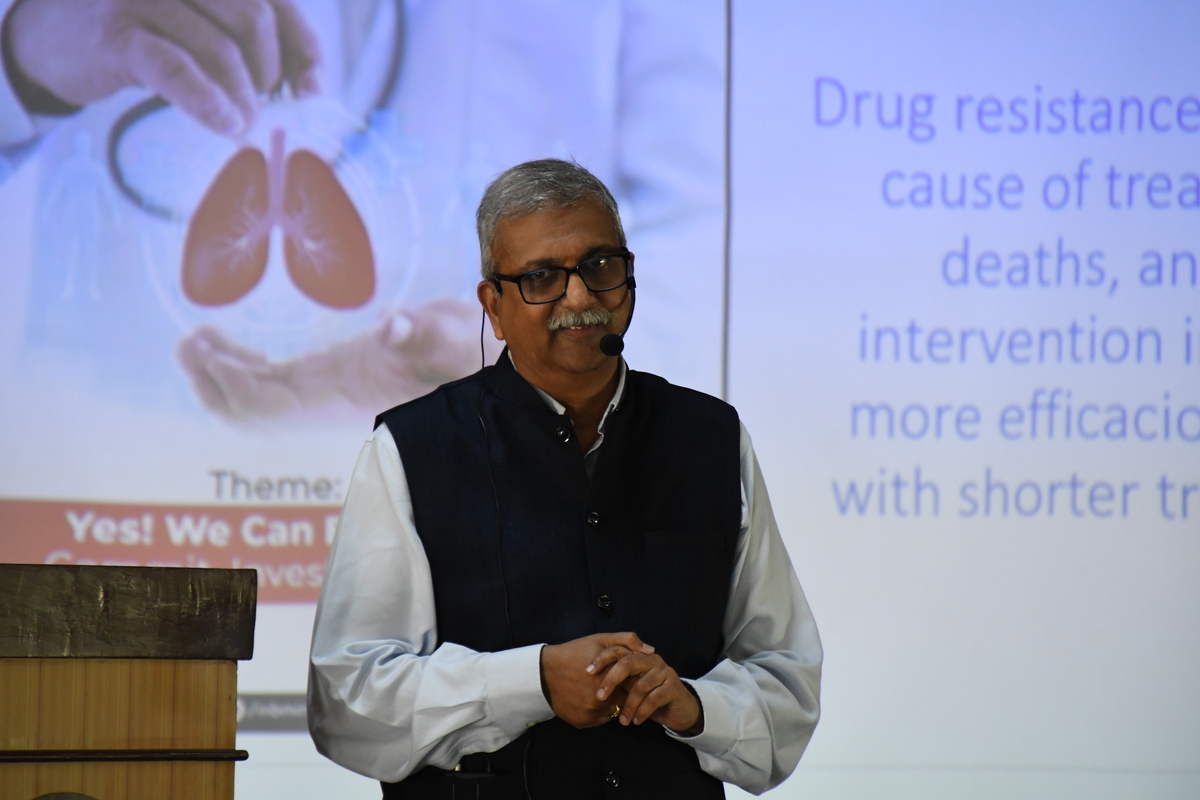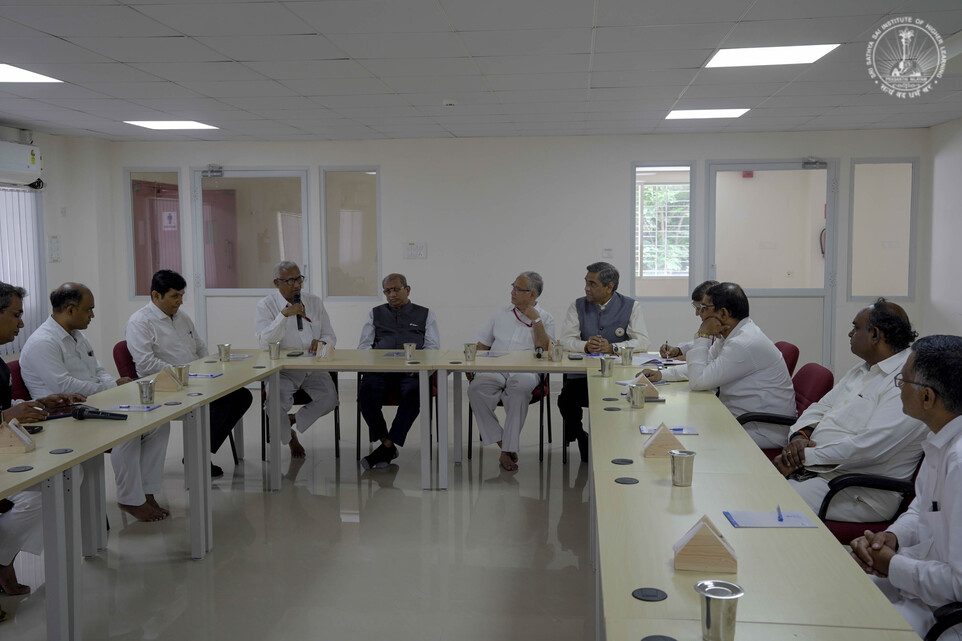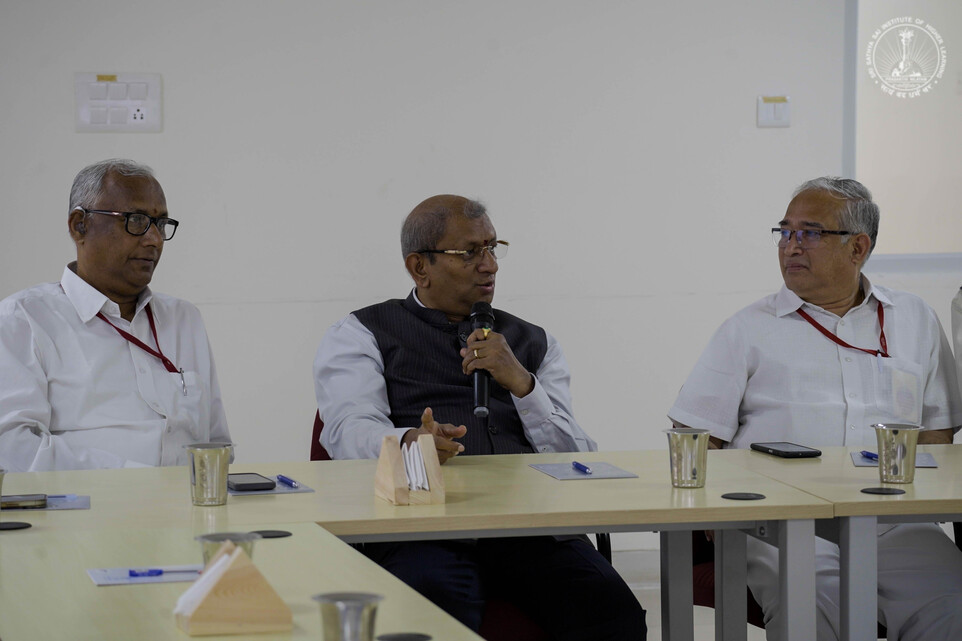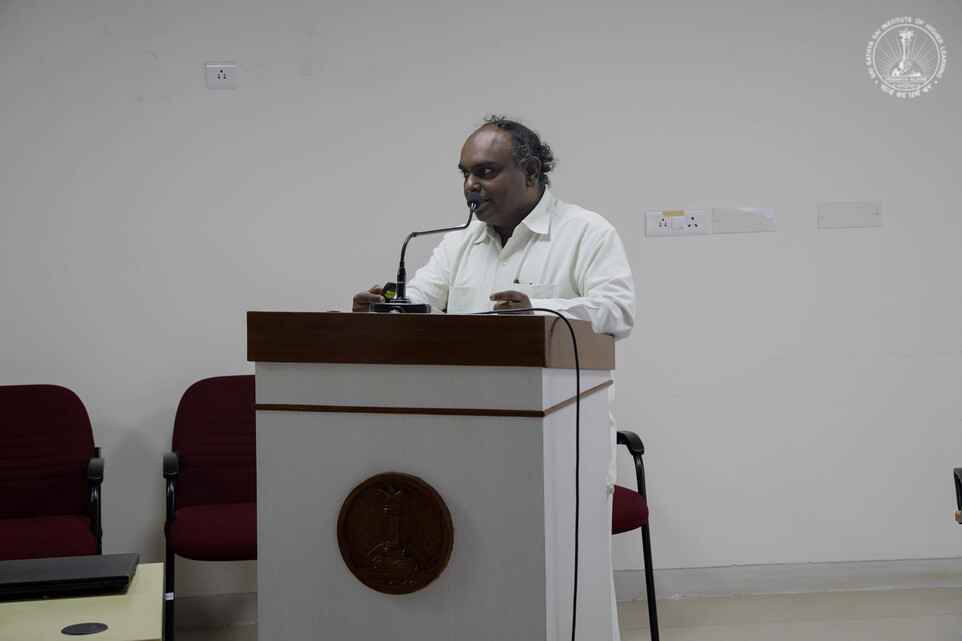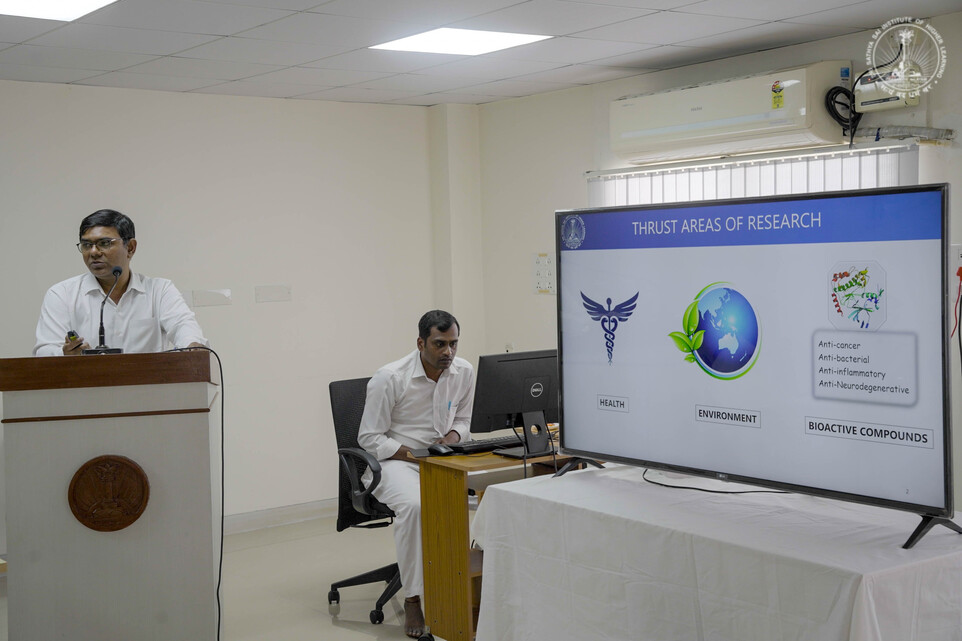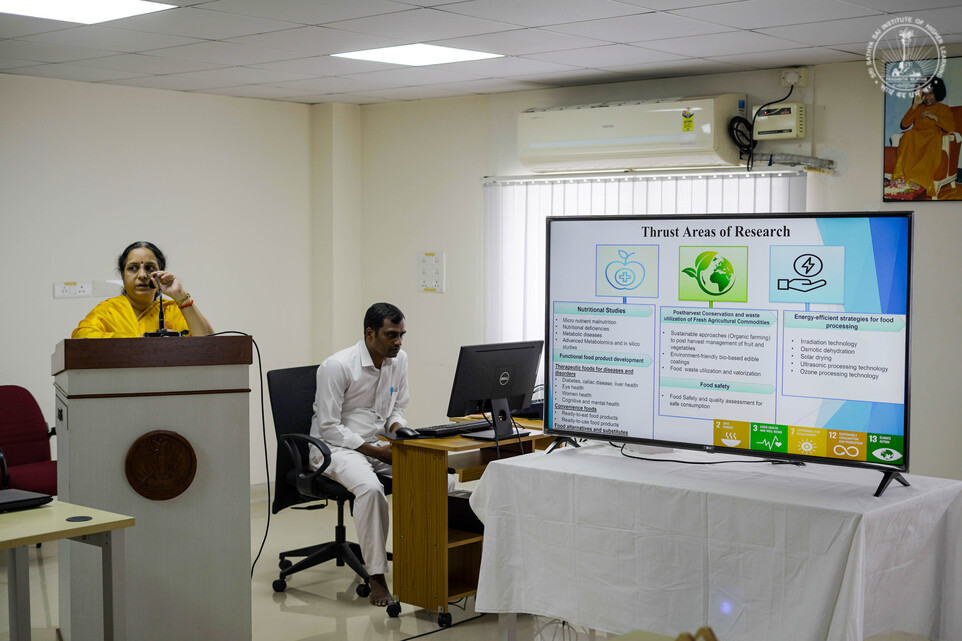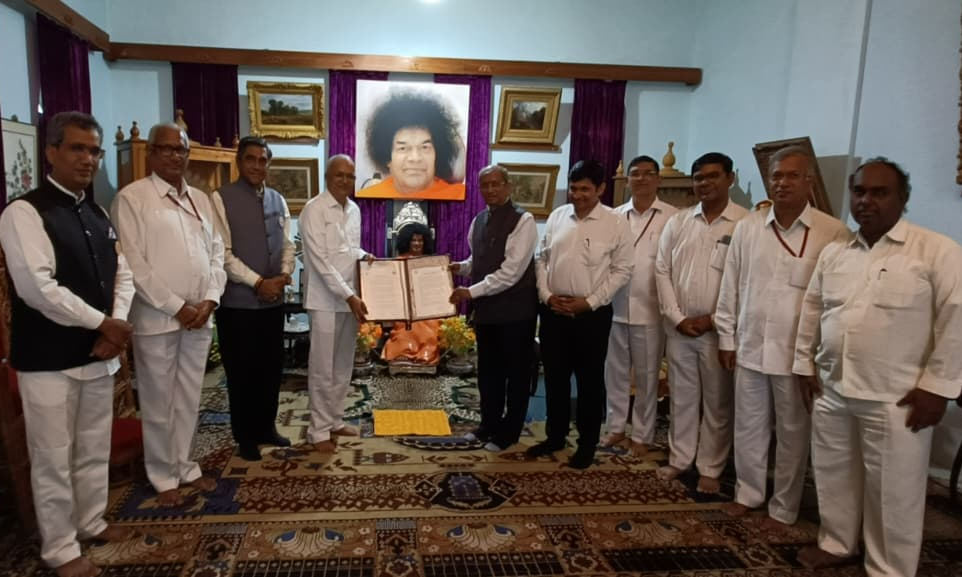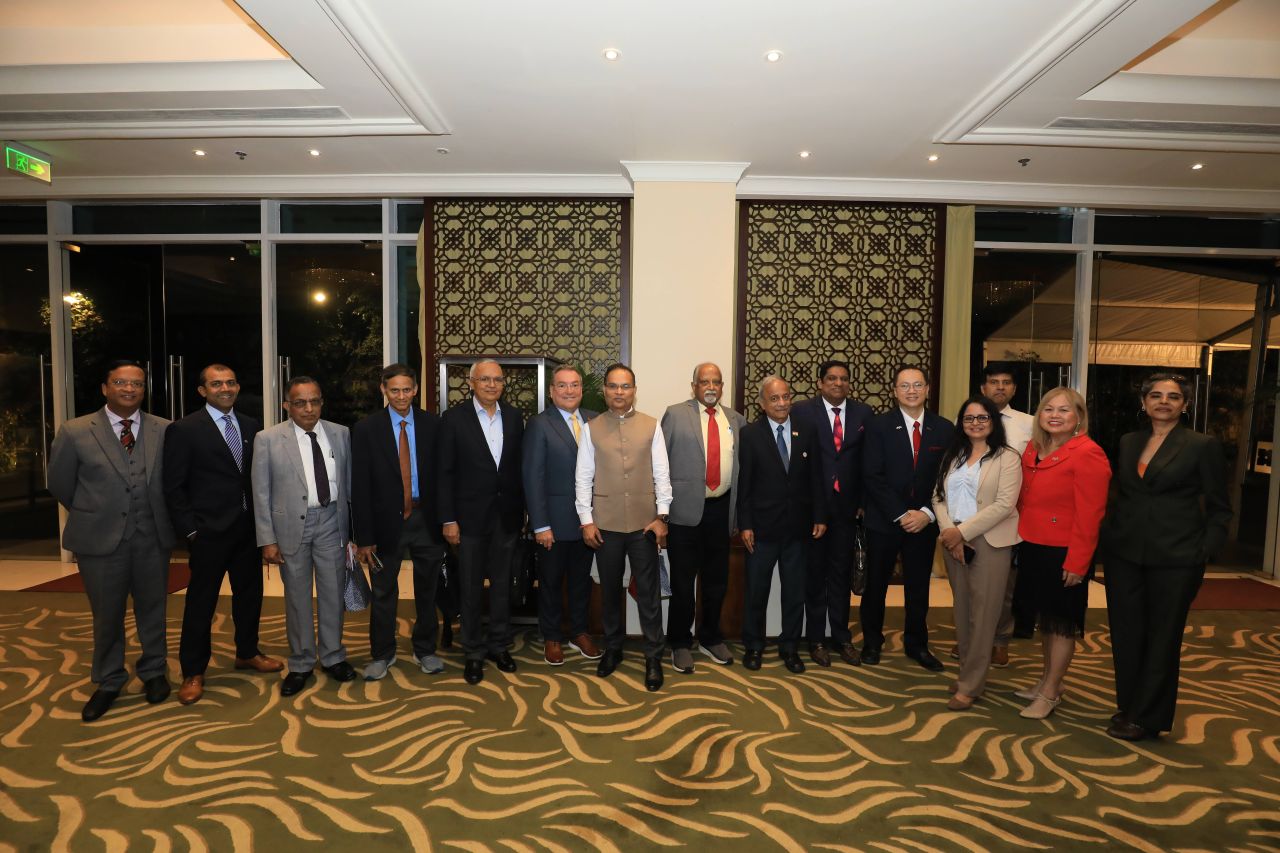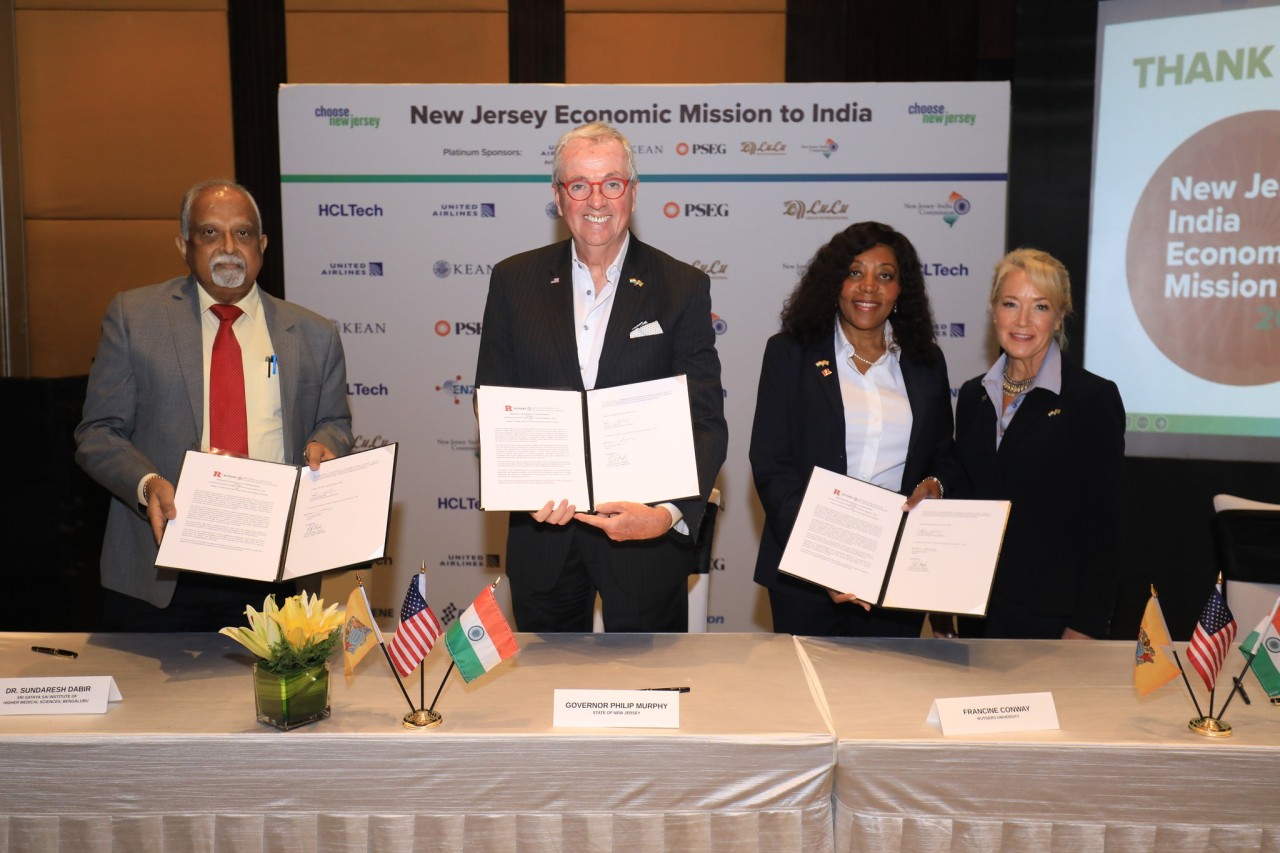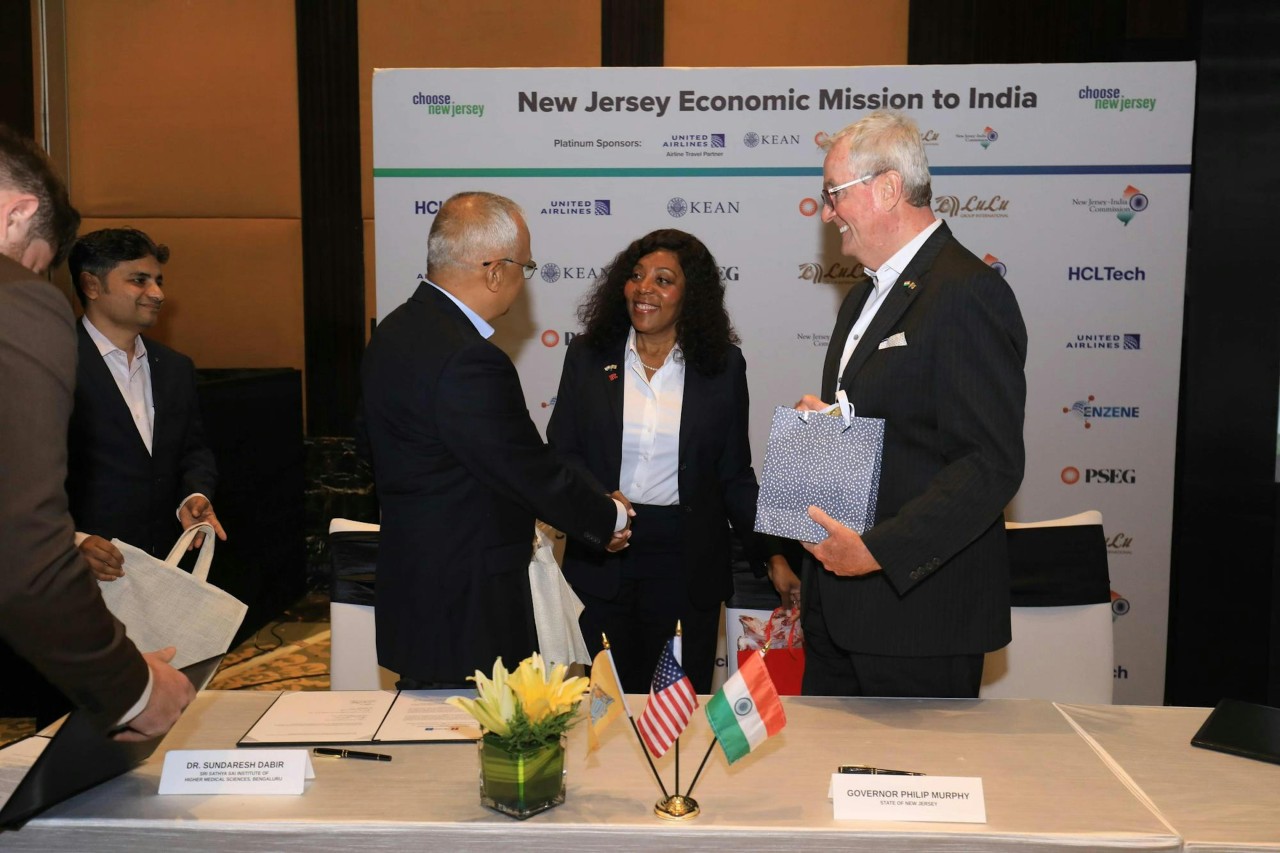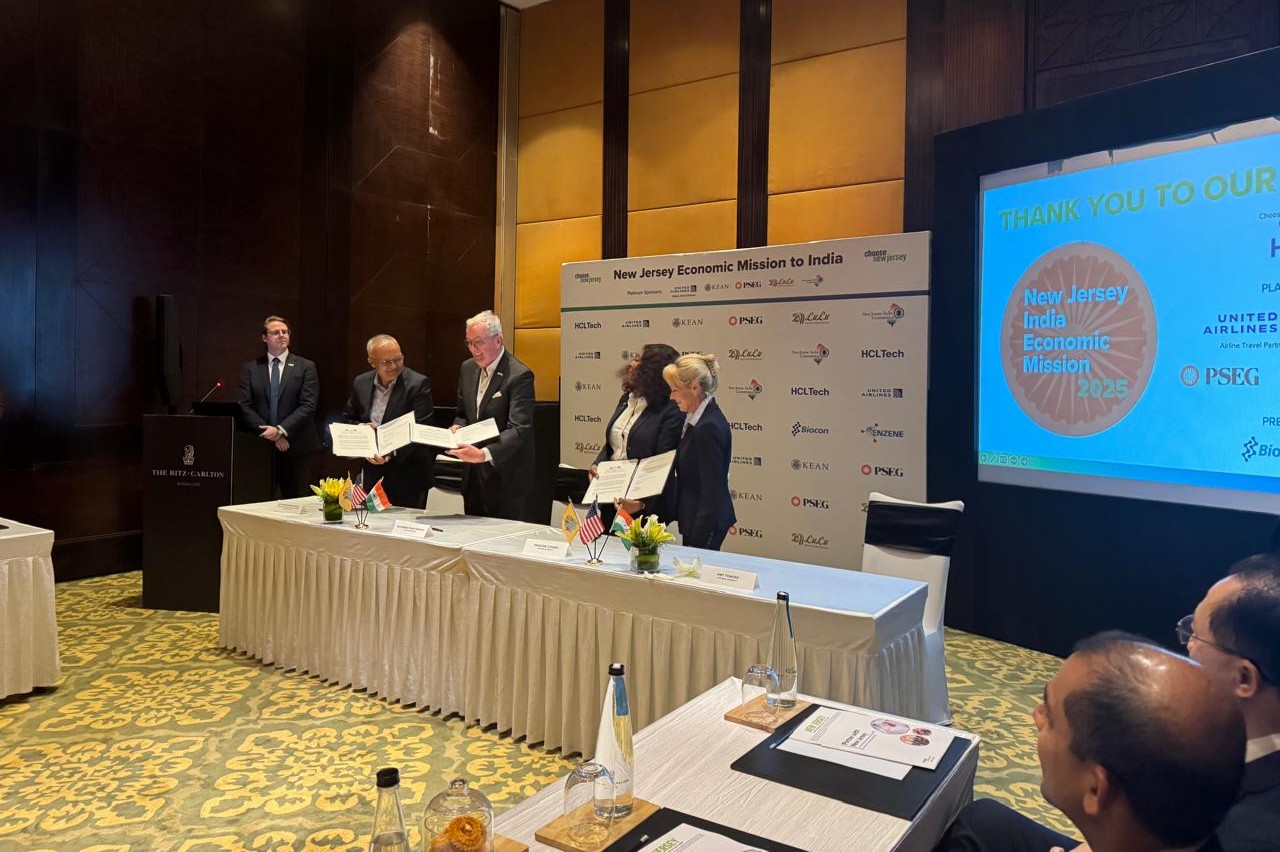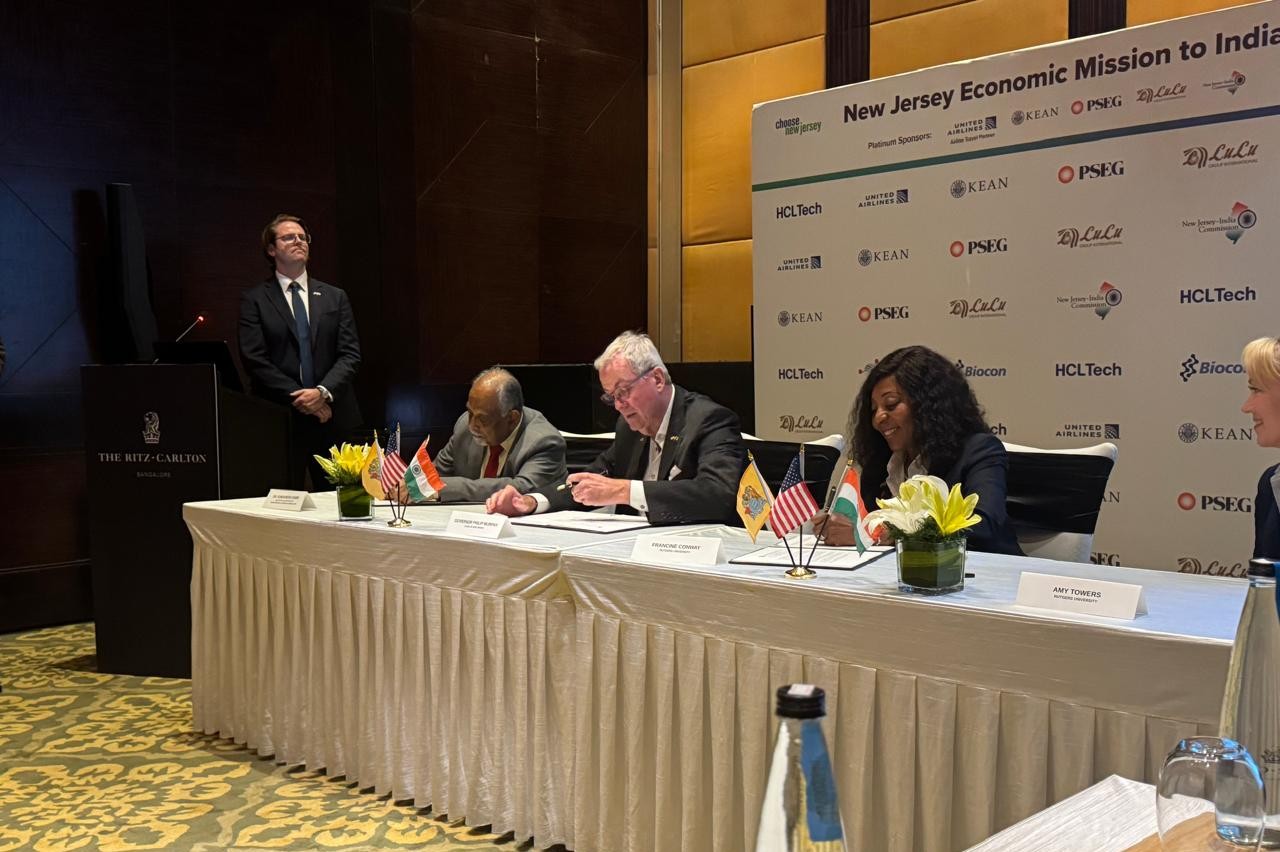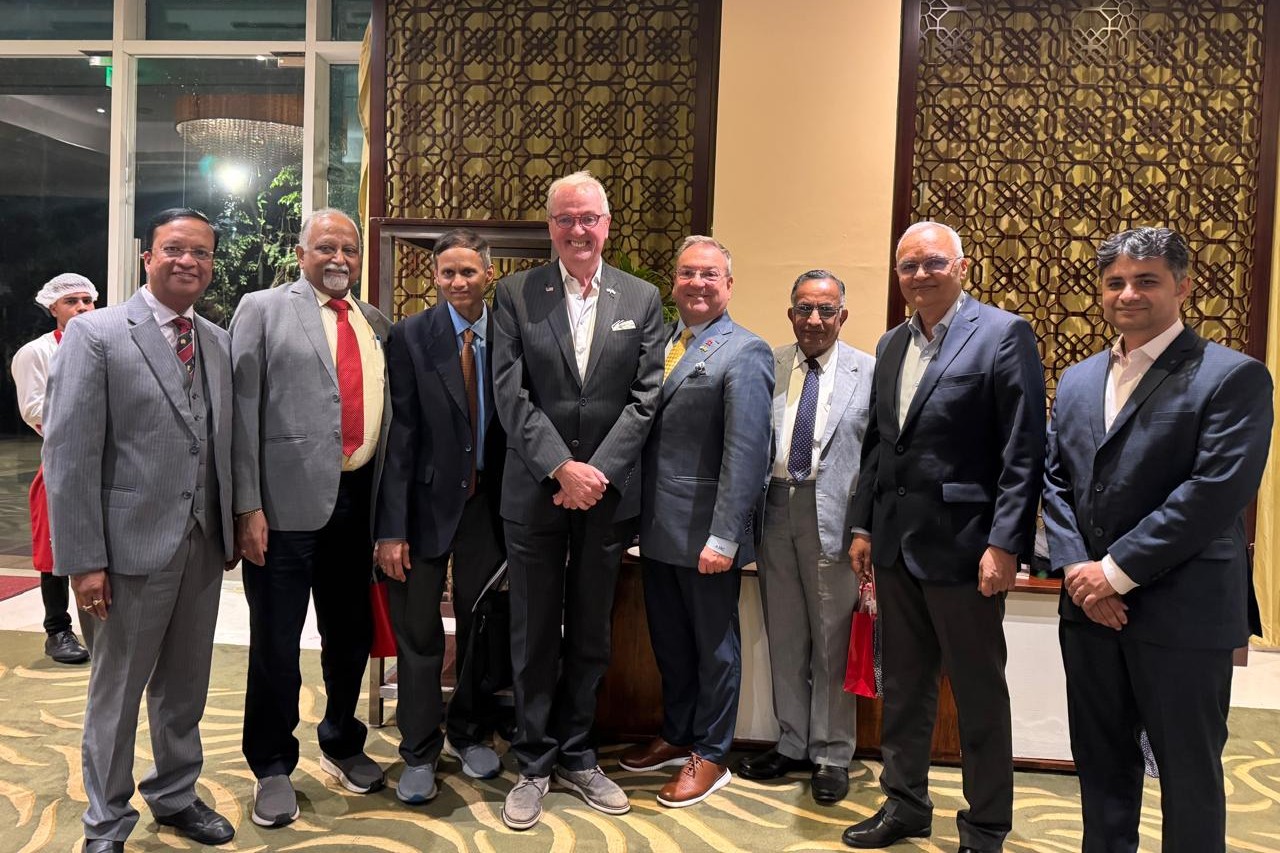With the divine blessings of Bhagawan Sri Sathya Sai Baba, Revered Founder Chancellor, SSSIHL, the Sri Sathya Sai Biobank & Research Hub (SSSBRH) – a joint offering of Sri Sathya Sai Institute of Higher Learning and the Sri Sathya Sai Medical Institutions — was inaugurated on 22 November 2025 by Shri C. P. Radhakrishnan, Hon’ble Vice President of India.
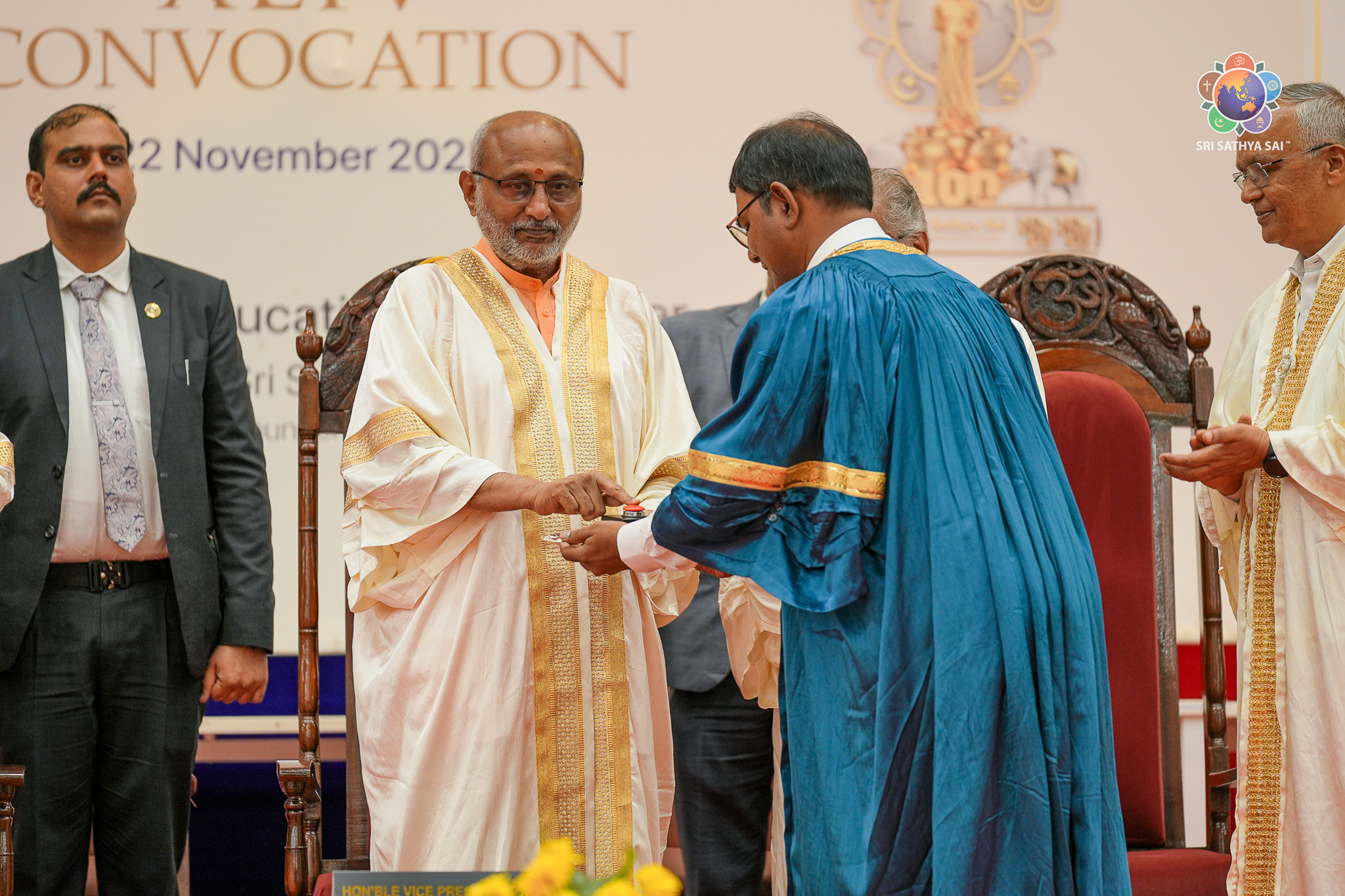
Hon’ble Vice President of India, Shri C. P. Radhakrishnan, inaugurates Sri Sathya Sai Biobank & Research Hub


SSSBRH – The National Solution
The state-of-the-art facility located in Prasanthi Nilayam, is poised to strengthen the nation’s capabilities significantly in the following areas:
- Biomedical research & innovation
- AI-enabled predictive healthcare
- Diagnostics, therapeutics & biosimilar development
- National and global research collaborations
Aligned with the Hon’ble Prime Minister’s vision of ViksitBharat2047, and India’s BioE3 Policy (Biomanufacturing, Biofoundry & BioAI), this Biobank will accelerate discovery science and support evidence-based healthcare across the country.


Building India’s Genomic Datasets
A biobank is essentially a high-tech library that stores millions of carefully collected human biological samples, such as blood, tissue, and DNA, along with detailed, protected health information. They help accelerate medical discoveries, leading to personalised medicine and improving public health through research.
India represents one-sixth of the world’s population but has less than 1% of the world’s genomic datasets. This gap means new treatments are often less effective or safe for Indians because they were not developed based on our population data.
Sri Sathya Sai Biobank addresses this gap. It is India’s first integrated precision medicine ecosystem.
The ethically collected samples (the biobank already has 25,000) will significantly enhance India’s genetic diversity, which is underrepresented in global medical research.
The Biobank will be an ISO 20387-compliant facility scalable to five million biospecimens in triplicate. It embodies the seamless integration of Sri Sathya Sai Educare and Medicare for the larger purpose of Sociocare.
SSSIHL’s AMRx® Honoured with Bronze at 2025 BRICS–ASEAN Tech Innovation Event
Sri Sathya Sai Institute of Higher Learning (SSSIHL) has been awarded the Bronze Medal in the AI & Digital Healthcare category at the 2025 Belt & Road and BRICS Competition of Skills Development and Technology Innovation (ASEAN International Competition) in Malaysia.
The winning innovation, AMRx® — AI/ML Clinical Decision Support for UTI & AMR (Application ID: I-2025BR002-ASEAN-002), is an advanced artificial intelligence and machine learning–based clinical decision support system that assists in the early detection and management of Urinary Tract Infections (UTI) and Antimicrobial Resistance (AMR). This impactful solution demonstrates SSSIHL’s commitment to leveraging technology for societal well-being and improving healthcare outcomes.
The BRICS-ASEAN International Competition 2025 is organized in alignment with the Kazan Declaration adopted at the 16th BRICS Summit, promoting global collaboration in education, training, skills development, science, technology, and innovation. The event is jointly hosted by the BRICS Business Council, Indonesian Ministry of National Development Planning (Bappenas), Indonesian National Research and Innovation Agency (BRIN), Malaysian Ministry of Education, and the Malaysian Industry and Government High-Tech Alliance.
SSSIHL’s recognition at this prestigious international platform reflects its growing contributions to futuristic healthcare technologies and reinforces its mission of integrating academic excellence with social impact.
Popular Science Talk Series 2025 – A Report
As part of the Sri Sathya Sai Centenary Celebrations, the Centre for Excellence in Mathematical Biology (CEMB) at the Sri Sathya Sai Institute of Higher Learning (SSSIHL), in collaboration with the Indian Society for Mathematical Modeling and Computer Simulation (ISMMACS), organized a Virtual Popular Science Talk Series from February to August 2025.
Held on the first Saturday of every month, the series featured eminent academicians and researchers from India and abroad, who shared insights across diverse scientific disciplines such as Mathematical Ecology, Epidemiology, Data Analytics, Artificial Intelligence, Bioinformatics, and Food & Nutritional Sciences.
Distinguished speakers included Prof. Peeyush Chandra (IIT Kanpur), Prof. Joydip Dhar (ABV-IIITM Gwalior), Prof. Arni S.R. Srinivasa Rao (Medical College of Georgia, USA), Prof. Ashok Srinivasan (University of West Florida, USA), Dr. Rani Madhavapeddi Patel (DeVry University, USA), and Prof. Balram Dubey (BITS Pilani).
Each talk showcased the transformative potential of mathematical and interdisciplinary approaches in solving contemporary challenges — from infectious disease modeling and artificial intelligence to sustainable agriculture and the gut-brain connection. The series attracted over 340 participants from academia, research, and industry across India.
Read More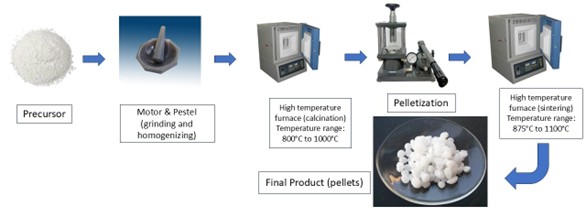
Boosting Sensor Efficiency with Low-Temperature, Lead-Free Ceramic Innovation
Identifying the Issue
- The 1.5 wt% B₂O₃ composition exhibited optimal performance, achieving a high piezoelectric coefficient (d₃₃ = 210 pC/N).
- B₂O₃ addition is an effective strategy for tailoring the microstructure and enhancing the multifunctional performance of lead-free BNT–BT–KNN ceramics for eco-friendly piezoelectric and energy storage applications
Objective of the Research
- To investigate the structural, dielectric, and electrical properties of lead-free BNT-BT-KNN ceramics modified with suitable dopants for enhanced piezoelectric performance.
- To establish the correlation between microstructural evolution and functional properties, enabling the development of environmentally friendly piezoelectric materials with improved densification and conductivity.
Who should read this?
Researchers and scientists in materials science and sensor technology
Solution
This study offers valuable insight into optimizing dopant concentration for improved control over the morphological, dielectric, and ferroelectric behavior related ceramic systems
Key Features and Benefits
- The developed lead-free BNT–BT–KNN system offers a sustainable substitute for toxic PZT-based ceramics without compromising functional performance.
- Controlled dopant incorporation improves polarization, dielectric constant, and AC conductivity, leading to superior piezoelectric response.
- Optimized sintering and additive engineering promote uniform grain growth and high relative density, directly enhancing electrical characteristics.
- Improved thermal stability and dielectric behavior makes the material suitable for energy harvesting, actuator, and sensing applications.
Impact
- The optimized lead-free BNT–BT–KNN ceramics achieved ~10–15% higher dielectric constant and ~20% reduction in dielectric loss, enabling more efficient piezoelectric devices.
- Incorporation of dopants reduced the sintering temperature by 50–100°C, leading to energy savings of nearly 10–12% during large-scale fabrication.
- The optimized composition demonstrates piezoelectric coefficients (d₃₃) and dielectric tunability comparable to commercial PZT, making it a viable candidate for energy harvesters, ultrasonic transducers, and smart sensors.
Team
- Kiran Kumar Padhi (first author) (SSSIHL)
- Dr Swarup Kundu (Corresponding author) (SSSIHL)
- Rohit Pattar (SSSIHL)
Title of paper: “Nanoarchitectonics of BNT-BT-KNN ceramics with B₂O₃ Assisted low temperature sintering for enhanced piezoelectric and energy storage properties”
Read Paper Here: 10.1007/s00339-025-08947-4
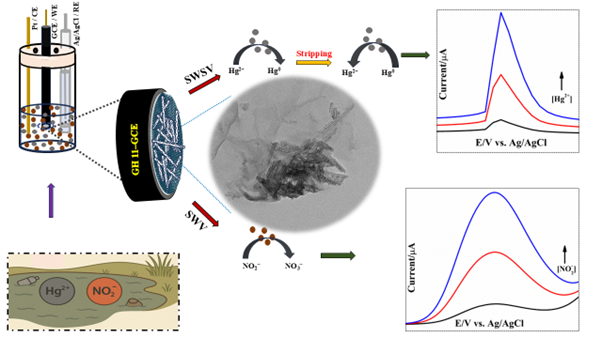
Innovative Nano-Sensor Simplifies Water Quality Checks by Detecting Two Pollutants Simultaneously
Identifying the Issue
- The presence of toxic ionic pollutants such as mercuric (Hg²⁺) and nitrite (NO2−) ions in water sources pose significant environmental and health concerns.
- Although various nanomaterial-based electrochemical sensors have been developed for individual ion detection, dual-ion sensing platforms remain scarce.
Objective of the Research
- Develop an efficient dual-function electrochemical sensor for the simultaneous detection of Hg²⁺ and NO2− ions in water using a nanocomposite of graphene oxide and hydrogen titanate nanotubes.
Who should read this?
- Environmental scientists, researchers, and engineers – Developing advanced nanomaterial-based electrochemical sensing platforms for real-time detection of chemical water contaminants.
- Water treatment industries and policymakers – Implementing integrated sensing platforms for improved water quality monitoring and regulation.
Solution
A novel electrochemical sensor of graphene oxide-hydrogen titanate nanotubes nanocomposite for simultaneous detection of both mercuric (Hg²⁺) and nitrite (NO₂⁻) ions in aqueous systems.
Key Features and Benefits
- Time & Cost-efficient: Simultaneous detection of two pollutants in a single test reduces resources, analysis time, and
- Dual-Ion Sensing Capability: Measures both cationic (Hg²⁺) and anionic (NO₂⁻) contaminants, enhancing the scope of water quality assessment.
- Environmentally Relevant: Facilitates early detection of toxic contaminants, preventing ecological damage and human exposure risks.
Impact
- Enhances Water Safety: Accurately detects Hg²⁺ and NO₂⁻ at low concentrations, ensuring safe drinking.
- Improves Monitoring Efficiency: Enables simultaneous multi-ion detection, reducing testing time by over 50% compared to conventional single-ion analysis methods.
Team
- Dasari Swarna
- Lokeswara Reddy S
- Sushma Tripathi
- Anjana Biswas
- Ganesh V (Corresponding author)
- Prathibha C (Corresponding author)
Title of paper: “A dual-target electrochemical sensor for simultaneous detection of mercuric and nitrite ions in water using a nanocomposite of graphene oxide and hydrogen titanate nanotubes”
Read Paper Here: https://doi.org/10.1016/j.microc.2025.115488
International Microorganisms Day 2025 – A Report
The Department of Biosciences, Sri Sathya Sai Institute of Higher Learning (SSSIHL), Prasanthi Nilayam Campus, celebrated International Microorganisms Day 2025 from 15–17 September 2025 on the theme “Sūkṣmānām Mahattvam – Tiny Creatures, Giant Impact.”
The three-day program featured eminent lectures, oral and poster presentations, a microbiology quiz, and an agar art workshop. Distinguished scientists from India and abroad delivered lectures on diverse aspects of microbiology, inspiring young researchers. A total of 45 abstracts were received, leading to 13 oral presentations and 32 poster presentations, while 33 students participated in the agar art workshops. Quiz competitions engaged both school and undergraduate students, fostering healthy competition and scientific curiosity.
The event also included the Dr. K. Gopinatha Rao Memorial Lecture, a documentary screening, and the inauguration of the DBIOS students’ club “RuBis.CO.” Prizes were awarded to outstanding participants across categories.
The celebration successfully combined science and creativity, providing a vibrant platform for students and researchers to share knowledge, develop skills, and appreciate the profound impact of microorganisms on human life and the environment.
Smart Hydrogel Film Makes Gas Detection Safer for Health and Industry
Identifying the Issue
- Existing sensors based on metal oxide semiconductors are limited by high temperature operation, response to different gases (poor selectivity) and non-flexible nature
- In this aspect, hydrogels with their interesting physical and chemical properties have attracted in designing the flexible sensors
Objective of the Research
Study the hybrid hydrogels to design gas sensors and tune the properties to high selectivity, with enhanced response for wearable applications
Who should read this?
- Research community working on gas sensors, hydrogels, flexible electronics.
- Industrial safety experts, and pharmaceutical industry.
Solution
Room temperature operable, flexible hydrogels which are selective to particular target gas interactions. Investigate hybrid hydrogel networks films to enhance the selectivity and sensitivity.
Key Features and Benefits
- hybrid hydrogel system formed by Laponite (a synthetic nanoclay) and Sodium Alginate (a natural polyelectrolyte) over the flexible polyethylene terephthalate (PET) substrates
- Have shown enhanced response with high selectivity towards ammonia gas sensing
- Ammonia interacts through ionization, thus forming NH4+, which causes releasing of Na+ ions in the hydrogel network. This differs from other gases and has resulted in high ammonia selectivity and an enhanced response
- Robust performance under humidity, ensuring stability.
- Suitable for wearable/health-related applications.
Impact
- Achieved a low detection limit of 7 ppm, making it suitable for environmental and biomedical monitoring.
- Rapid response (31 s) and recovery (84 s) at 1000 ppm.
- The sensing mechanism based on ion-exchange interactions between Na⁺ in the hydrogel and NH₄⁺ which is unique to ammonia with these hybrid hydrogels.
Team
- Tanay Saha (first author) (SSSIHL)
- Paramesh Gadige (Corresponding author) (SSSIHL)
Title of paper: “Highly selective ammonia gas sensing response by hybrid Laponite-sodium alginate hydrogel films on flexible substrates“
Read Paper Here: https://doi.org/10.1016/j.microc.2025.115423
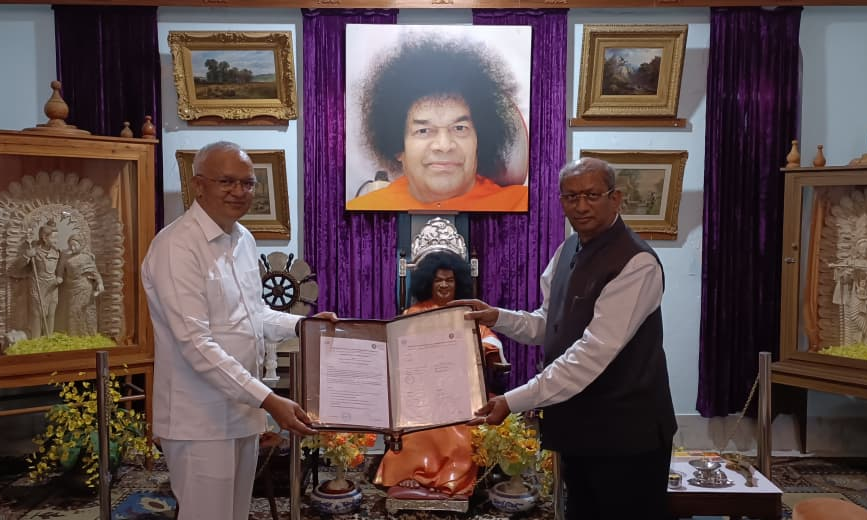
SSSIHL and VTU Forge Strategic Partnership to Enhance Student Opportunities and Research Excellence
Sri Sathya Sai Institute of Higher Learning (SSSIHL), Prasanthi Nilayam, and Visvesvaraya Technological University (VTU), Belagavi, Karnataka, signed a Memorandum of Understanding (MoU) on 25 September 2025 to strengthen academic collaboration and research initiatives. The MoU was exchanged between Prof. B. Raghavendra Prasad, Vice-Chancellor, SSSIHL, and Prof. Vidyashankar S., Hon’ble Vice-Chancellor, VTU, in the presence of senior officials from both institutions. As part of the occasion, the VTU delegation also visited the Central Research Instruments Facility (CRIF) at SSSIHL, where senior faculty members provided an overview of the state-of-the-art facilities and showcased ongoing research projects.
The MoU aims to strengthen academic cooperation and research collaboration between the two universities in areas of science, technology, and interdisciplinary studies.
Key Areas of Collaboration
- Student Exchange: Short-term project opportunities (1–12 months) for SSSIHL and VTU students at each other’s institutions.
- Specialized Courses: Credit transfer of approved courses across both institutions
- Joint Research: Collaborative research projects supported by internal or external funding.
- Joint Ph.D. Programs: Students may pursue joint Ph.D.s with supervisors from both institutions. VTU’s JRFs may register for Ph.D. programs at SSSIHL under joint supervision.
- Joint Master’s Programs: Initiate a joint MS/M.Tech. programs in mutual areas of interest
A Joint Committee will be formed to work out the detailed modalities, including scope, roles, responsibilities, IPR, finances, and other conditions, ensuring flexibility to adapt and expand collaboration.
The MoU marks a significant step towards advancing academic exchange, joint research, and collaborative degree programs, opening new avenues for students and faculty of SSSIHL and VTU to engage in impactful knowledge creation and dissemination.
Advancing Research and Innovation in Education & Healthcare: Rutgers University and Sri Sathya Sai Institutions Forge Global Partnerships
Prasanthi Nilayam, 24 September 2025:
In a significant step towards strengthening global academic and research partnerships, Sri Sathya Sai Institute of Higher Learning (SSSIHL), Prasanthi Nilayam, Puttaparthi, entered into an Abbreviated Memorandum of Understanding (MoU) with Rutgers, The State University of New Jersey, United States of America. This MoU was exchanged in the presence of Honorable Philip D. Murphy, Governor of New Jersey, during the Governor-led mission to India on 22 September 2025 in Bengaluru.
The collaboration reflects a shared vision of fostering innovation, advancing health sciences, and creating opportunities for students and researchers through international cooperation. The Division of Cardiovascular Disease and Hypertension at Rutgers Robert Wood Johnson Medical School will oversee the further development of this initiative.
MoU between Rutgers University and SSSIHL
The Abbreviated MoU between SSSIHL and Rutgers University records the intent of both institutions to explore future academic cooperation and research collaborations. The areas of potential partnership include:
- Education and Training: Facilitating exchange of undergraduate and graduate students, researchers, and faculty.
- Joint Research and Publications: Encouraging collaborative research projects and scholarly output.
- Academic Events: Organizing meetings, symposiums, and workshops to foster dialogue and innovation.
- Innovation and Entrepreneurship: Promoting cross-border collaborations in technology transfer, translational science, and digital health.
Potential fields of collaboration identified under the MoU include Cardiovascular Medicine, Cardiovascular Surgery, Medical Imaging, Artificial Intelligence, Digital Health, Tissue Engineering, Biobanking, and other emerging areas of translational science.
The MoU was exchanged by Prof. B Raghavendra Prasad, Vice Chancellor, SSSIHL, and Dr. Francine Conway, Chancellor of Rutgers–New Brunswick.
MoUs between Rutgers University and SSSIHMS
In addition to the partnership with SSSIHL, Rutgers University also entered into two separate MoUs with Sri Sathya Sai Institute of Higher Medical Sciences (SSSIHMS), Whitefield (Bengaluru) and SSSIHMS, Puttaparthi (Andhra Pradesh). These agreements aim to advance collaborative research in cardiovascular medicine, medical imaging, AI, digital health, and translational sciences and facilitate the exchange of expertise, joint symposia, and academic workshops and strengthen institutional capabilities in areas such as tissue engineering and biobanking.
The MoUs were exchanged by Dr. Francine Conway, Chancellor of Rutgers–New Brunswick with the respective Directors of SSSIHMS – Dr. Sundaresh Dabir, Director, SSSIHMS, Bengaluru, Dr. Gurumurthy, Director, and Dr. Anil Kumar Mulpur, Joint Director, SSSIHMS, Puttaparthi.
The partnerships between Rutgers University and the Sri Sathya Sai Institutions mark a milestone in fostering global cooperation in health sciences and education. They are expected to:
- Expand opportunities for student and researcher mobility
- Create platforms for knowledge sharing and innovation
- Strengthen global networks in medical and technological research
- Contribute to transformative advancements in healthcare delivery and translational research
The MoUs between Rutgers University, SSSIHL, and SSSIHMS reaffirm a shared commitment to advancing education, healthcare, and innovation through global partnerships. These agreements provide a strong foundation for collaborative initiatives that will benefit students, researchers, and society at large, aligning with the mission of Sri Sathya Sai Institutions to integrate academic excellence with societal impact.
View: Official release by the Office of the Governor, State of New Jersey
Notes for Editors (About Sri Sathya Sai Institute of Higher Learning)
Sri Sathya Sai Institute of Higher Learning (SSSIHL), a Deemed to be University in Prasanthi Nilayam, Puttaparthi, Andhra Pradesh, India, is one of the few institutions in the world offering values-based education to students at the University level, ever since its inception in 1981. Ethics and morals form the undercurrent of every subject taught at the institute providing its students with a holistic framework of interpersonal development combined with academic excellence. With a merit-based, open admissions policy, SSSIHL welcomes students from all backgrounds—irrespective of income, religion, or region—and provides quality education free of charge.
SSSIHL has four campuses across Andhra Pradesh and Karnataka, attracting students from all over India and offering a range of programmes at the undergraduate, postgraduate, professional, and research levels.
SSSIHL also provides a strong research environment, with exceptional academic practices, that have resulted in the growth of national and international collaborations. The Central Research Instruments Facility (CRIF), based at the Prasanthi Nilayam Campus is one of the few facilities in the country that houses advanced Characterisation / Analytical Tools to carry out Translational Research in various areas of Science and Technology.
For further information, visit: sssihl.edu.in.
Media contact: media@sssihl.edu.in. Tel: +91 8555 287239
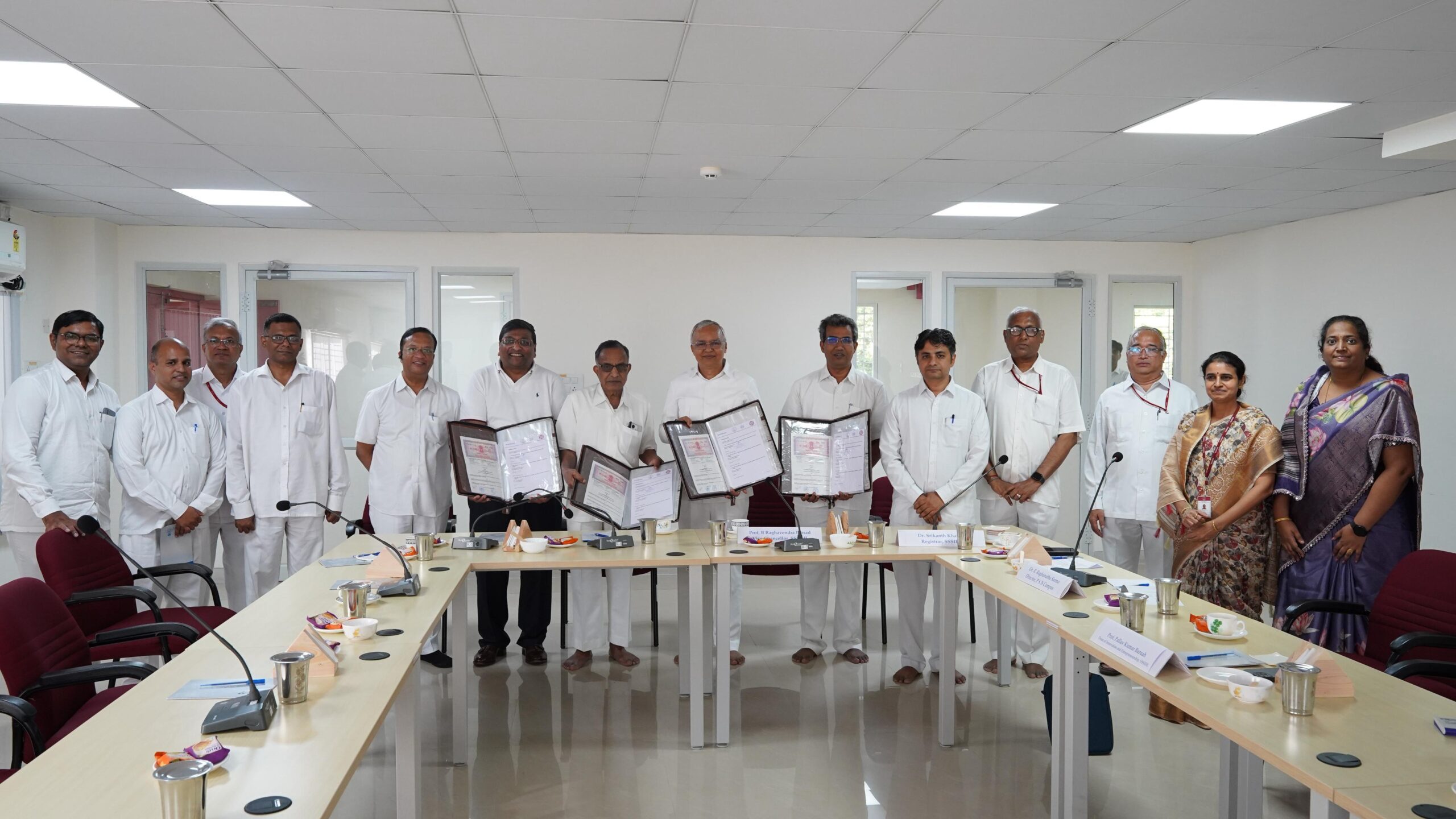
MoU between MediQlogix LLC, SSSIHL, SSSRIF and SSSIHMS-PG
On 4 September 2025, the Sri Sathya Sai Institute of Higher Learning (SSSIHL), along with its innovation arm, the Sri Sathya Sai Research and Innovation Foundation (SSSRIF), entered into a Memorandum of Understanding with MediQlogix LLC, USA and the Sri Sathya Sai Institute of Higher Medical Sciences, Prasanthi Gram (SSSIHMS-PG).
This MoU establishes a collaborative framework to advance healthcare research, innovation, and technology development. Key focus areas include AI/ML-powered digital health systems, advanced diagnostics, clinical imaging, medical data transcription and analysis, predictive healthcare solutions, and cost-effectiveness studies. The collaboration also provides unique opportunities for students, researchers, and clinicians to work alongside industry experts on real-world healthcare challenges, fostering impactful solutions for society.
The agreement was signed by Dr. Srikanth Khanna (Registrar, SSSIHL), Mr. T. L. Pavan Kumar (CEO, SSSRIF), Dr. Gurumurthy (Director, SSSIHMS-PG), Dr. Anil Kumar Mulpur (Joint Director, SSSIHMS-PG), and Mr. Deepak Adoni (Founder & CEO, MediQlogix LLC).
The MoU was formally exchanged between Prof. B. Raghavendra Prasad (Vice Chancellor, SSSIHL), Mr. Deepak Adoni (Founder & CEO, MediQlogix LLC), Dr. Gurumurthy (Director, SSSIHMS-PG), and Mr. T. L. Pavan Kumar (CEO, SSSRIF) in the presence of Dr. Srikanth Khanna, Dr. Anil Kumar Mulpur, and senior faculty members.
By combining MediQlogix’s expertise in healthcare technology with the academic and clinical strengths of SSSIHL, SSSRIF, and SSSIHMS-PG, this partnership seeks to redefine healthcare delivery and training, while upholding the highest standards of data privacy and ethics.
Read More

